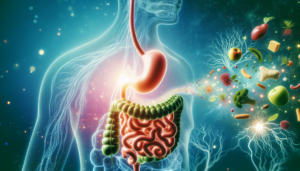The Connection Between Gut Flora and Weight Management
The Connection Between Gut Flora and Weight Management
Understanding Gut Flora
Gut flora, also known as gut microbiota, refers to the vast community of microorganisms residing in the gastrointestinal tract. These microorganisms, including bacteria, fungi, and archaea, play a crucial role in the body’s metabolism, immune regulation, and overall health. With approximately 100 trillion microbial cells in the human body, the gut flora’s composition can significantly influence various physiological functions.
Types of Gut Bacteria
Gut bacteria can be categorized into two primary types: beneficial (or "good") bacteria and harmful (or "bad") bacteria. Beneficial bacteria, such as Lactobacillus and Bifidobacterium, promote digestion, enhance immune function, and contribute to gut health. In contrast, harmful bacteria can lead to dysbiosis, a state of microbial imbalance that may cause digestive disorders and affect systemic health.
The Role of Gut Flora in Metabolism
-
Energy Harvesting
Gut flora plays an essential role in the extraction of energy from the diet, particularly from carbohydrates that are indigestible by human enzymes. For instance, certain gut bacteria can ferment dietary fibers, producing short-chain fatty acids (SCFAs) such as butyrate, propionate, and acetate. These SCFAs serve as an energy source for colon cells and can influence metabolism by modulating appetite-regulating hormones. -
Regulation of Fat Storage
Research indicates that gut microbiota composition affects fat storage and insulin sensitivity. Certain bacteria favor the storage of fat within adipose tissues, while others enhance energy expenditure. A notable study by Jeffrey Gordon and colleagues demonstrated that individuals with obesity have distinct gut microbiota profiles compared to lean individuals, with an increase in Firmicutes and a decrease in Bacteroidetes linked to higher fat accumulation. - Metabolic Endotoxemia
Dysbiosis can lead to increased intestinal permeability, often referred to as "leaky gut," allowing toxic substances, or endotoxins, to enter the bloodstream. This condition is associated with chronic inflammation, which may contribute to insulin resistance and weight gain. Studies suggest that gut flora can mediate the levels of circulating endotoxins, affecting the body’s metabolic response.
Gut Flora and Appetite Regulation
-
Hormonal Regulation
Gut bacteria influence the production of hormones related to appetite regulation, such as ghrelin and leptin. Ghrelin, often referred to as the "hunger hormone," stimulates appetite, while leptin signals satiety. Certain gut microbiota can enhance the secretion of leptin and decrease ghrelin levels, promoting a balanced appetite. - Mediating Food Preferences
Studies reveal that gut bacteria can affect food cravings and preferences. For example, certain bacteria may encourage the consumption of high-calorie, sugar-laden foods, perpetuating a cycle of unhealthy eating. Additionally, probiotics may help modify these preferences towards healthier options, supporting weight management efforts.
The Impact of Diet on Gut Flora
-
Fiber-Rich Diets
A diet rich in dietary fiber promotes the growth of beneficial gut bacteria. Fiber acts as a prebiotic, feeding good bacteria and stimulating their proliferation. Incorporating foods such as fruits, vegetables, legumes, and whole grains can enhance gut diversity and overall microbial health, leading to favorable metabolic effects. -
High Sugar and Fat Intake
Conversely, diets high in sugar and saturated fats can distort gut microbiota composition, promoting the growth of harmful bacteria. This shift can lead to increased inflammation and perturbed metabolism. Shifting to a balanced diet is vital for restoring gut health and supporting weight management. - Fermented Foods
Including fermented foods, such as yogurt, kefir, and kimchi, can introduce beneficial probiotics into the gut. These foods not only contribute to a diverse gut flora but can also help balance microbial populations, enhancing metabolic health and promoting effective weight management.
Probiotics, Prebiotics, and Weight Management
-
Probiotics
Probiotics are live bacteria that confer health benefits when consumed in adequate amounts. Clinical studies suggest that specific probiotic strains, such as Lactobacillus gasseri and Bifidobacterium lactis, may assist with weight loss and fat reduction, especially when combined with diet and exercise interventions. - Prebiotics
Prebiotics are non-digestible food components that stimulate the growth of beneficial bacteria. Common sources of prebiotics include chicory root, garlic, onions, and bananas. Increasing prebiotic intake can lead to a more diverse gut microbiota, optimizing metabolic functions and aiding in weight management.
Personalized Nutrition and Gut Microbiota
-
Individual Variability
The composition of gut flora varies significantly among individuals due to genetic, environmental, and lifestyle factors. As a result, personalized nutrition approaches tailored to an individual’s unique gut microbiota may enhance weight management efforts. Understanding one’s gut profile can inform dietary choices that optimize metabolic health. - Microbiome Testing
Emerging microbiome testing technologies allow individuals to analyze their gut flora composition. This information can guide dietary and lifestyle changes that promote healthy gut bacteria, potentially leading to more effective weight management strategies tailored to individual needs.
The Future of Gut Flora Research
Research on gut flora and its connection to weight management is continually evolving. Ongoing studies aim to elucidate the intricate relationships between gut microbiota, dietary patterns, and metabolic health. As understanding deepens, innovative therapeutic strategies involving microbiota modulation, such as fecal microbiota transplants (FMT) and targeted prebiotic/probiotic supplementation, may revolutionize weight management approaches.
Conclusion
Emphasizing the connection between gut flora and weight management opens new opportunities for improving health. By fostering a diverse and balanced gut microbiota through diet and probiotics, individuals may enhance their metabolic functions, regulate appetite, and, ultimately, support effective weight management. Understanding this complex relationship is crucial for future wellness strategies, highlighting the essential role of gut health in overall nutrition and lifestyle choices.








